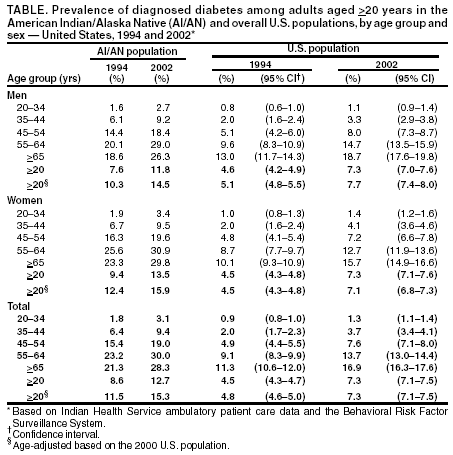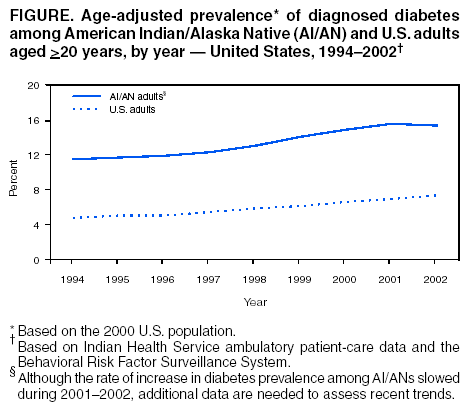 |
|
|
|
|
|
|
| ||||||||||
|
|
|
|
|
|
|
||||
| ||||||||||
|
|
|
|
|
Persons using assistive technology might not be able to fully access information in this file. For assistance, please send e-mail to: mmwrq@cdc.gov. Type 508 Accommodation and the title of the report in the subject line of e-mail. Diabetes Prevalence Among American Indians and Alaska Natives and the Overall Population --- United States, 1994--2002Diabetes affects American Indians/Alaska Natives (AI/ANs) disproportionately compared with other racial/ethnic populations (1) and has been increasing in prevalence in AI/AN populations during the past 16 years (1,2). To examine trends in diabetes prevalence among AI/ANs and the overall U.S. population and to describe disparities among these two populations, CDC analyzed data from the Indian Health Service (IHS) and the Behavioral Risk Factor Surveillance System (BRFSS). This report summarizes the results of that analysis, which indicate that diabetes continues to affect AI/ANs disproportionately and is becoming more common among younger populations. To combat this epidemic, knowledge and interventions from clinical trials and best-practice models should be translated to community-based prevention programs within AI/AN communities. IHS operates a health-services system delivered directly through IHS facilities, purchased by IHS through contractual agreements with private providers, or delivered through tribally operated programs and urban Indian health programs (3). Approximately 60% of the estimated 2.5 million AI/ANs living in the United States are eligible to receive IHS services and use IHS medical facilities (3). Diabetes cases among AI/ANs aged >20 years were identified by using the International Classification of Diseases, Ninth Revision, Clinical Modification (ICD-9-CM) diagnostic codes 250.0--250.9 from the IHS's ambulatory patient care computerized system for 1994--2002. The ambulatory patient care database includes unduplicated case reports for persons who attended an IHS service unit one or more times during each of the years studied. Ambulatory care data were reported from 123 (79%) of 156 service units; 33 service units (representing 5% of the AI/AN population using IHS services) were excluded because of incomplete reporting. Prevalence was calculated by using the AI/AN population that received health-care services at IHS, tribal, or urban facilities at least once during the preceding 3 years. Prevalence of self-reported diabetes among persons of similar age was obtained from BRFSS for the same period. BRFSS is a state-based, random-digit--dialed telephone survey of the U.S. civilian, noninstitutionalized population aged >18 years. Surveys are conducted in all 50 states, the District of Columbia, and three U.S. territories; in 2002, the median response rate was 58.3% (range: 42.2%--82.6%). Persons with diabetes were defined as respondents who answered "yes" to the question, "Has a doctor ever told you that you have diabetes?" Women who were told that they had diabetes only during pregnancy were not included. BRFSS data were weighted to reflect the age, sex, and racial/ethnic distribution of the U.S. population. Data were analyzed by using SAS (version 8) software with SUDAAN to estimate standard errors. Taylor approximations were used to estimate 95% confidence intervals (CIs) on the relative increase of diabetes prevalence during 1994--2002 (4). Prevalence was age-adjusted by using the direct method based on the 2000 U.S. standard population. During 1994--2002, the age-adjusted prevalence of diabetes increased 54.0% (95% CI = 46.7%--61.4%) among U.S. adults, from 4.8% to 7.3%, and increased 33.2% among AI/AN adults, from 11.5% to 15.3% (Figure). Throughout the surveillance period, the overall age-adjusted prevalence for AI/AN adults was more than twice that of U.S. adults overall. Across all sex and age groups in both the AI/AN and overall U.S. adult populations, the prevalence of diagnosed diabetes was higher in 2002 than in 1994 (Table). In 1994 and 2002, diabetes prevalence increased with age for U.S. adults and increased up to age >65 years for AI/AN adults. Overall, the age-specific prevalence of diagnosed diabetes was two to three times higher for AI/AN adults than for U.S. adults. In 2002, approximately 30% of AI/ANs aged >55 years had diabetes. Although prevalence was lowest among younger persons in both populations, the larger relative increases during 1994--2002 were 73.7% for AI/ANs aged 20--34 years, from 1.8% to 3.1%, and 86.8% (95% CI = 60.5%--113.1%) for U.S. adults aged 35--44 years, from 2.0% to 3.7%. Reported by: KJ Acton, National Diabetes Program, Indian Health Svc. NR Burrows, MPH, LS Geiss, MA, T Thompson, MS, Div of Diabetes Translation, National Center for Chronic Disease Prevention and Health Promotion, CDC. Editorial Note:Diabetes is associated with severe and costly complications (e.g., blindness, kidney failure, lower-extremity amputation, and cardiovascular disease), disability, decreased quality of life, and premature death (5) that continue to affect AI/ANs disproportionately. In addition, diabetes is becoming more common in both the AI/AN and overall U.S. populations, and the larger increase in diabetes prevalence among young adults during 1994--2002 presents an additional public health concern. Earlier onset increases the lifetime duration of the disease, the risk for costly and disabling diabetes-related complications, and health concerns for young women of child-bearing age because both women who had diabetes during pregnancy and their offspring might be at increased risk for developing the disease (5). The findings in this report are subject to at least five limitations. First, prevalence of diabetes probably was underestimated because the data did not represent persons with undiagnosed disease. Second, IHS data accounted only for those persons who used IHS or tribal health facilities. The higher age-specific prevalence of diabetes among AI/AN women might be attributable to women seeking health care at IHS or tribal health facilities more frequently than men (3). Third, 5% of the IHS population was excluded from this analysis because of incomplete data. Fourth, information on diabetes prevalence is missing for approximately 40% of the AI/AN population who do not reside on or near reservations and who do not receive care from IHS or tribal health facilities (3). Whether they are more or less likely to have diabetes is unknown. Finally, data are not available for U.S. persons without telephones (who are likely to be of low socioeconomic status) who have had diabetes diagnosed (5). Despite these limitations, IHS data are sufficiently consistent to estimate trends over time (1), and BRFSS survey data have minimal bias compared with census data (BRFSS data quality report; available at http://www.cdc.gov/brfss). In addition, research has demonstrated agreement between administrative and survey data in identifying persons with diabetes (6). Although the increase in diabetes prevalence might, in part, reflect better case ascertainment, population-based studies suggest that it might represent a true increase in disease incidence caused, in part, by the increasing prevalence of obesity (7). The prevalence of diabetes will likely continue to increase as the U.S. population ages and as the prevalence of risk factors (e.g., obesity) increases (5). Interventions that promote exercise, improve nutrition by reducing fat and calorie intake, and reduce body weight have been shown to prevent or delay onset of disease among persons at risk for developing type 2 diabetes (8). Among persons with diabetes, appropriate health-care practices (e.g., aggressive control of hyperglycemia and hypertension) can prevent or delay diabetes-related complications (e.g., eye disease, kidney disease, or nerve damage, which is a precursor to foot disease and lower-extremity amputation) (9). In 1997, the Balanced Budget Act provided $150 million in grants to the IHS for diabetes-prevention and treatment programs. Through national consultation and close partnership with tribal leadership, the IHS has used these funds to establish approximately 350 new diabetes programs in AI/AN communities. The majority of these programs focus on diabetes prevention and health promotion, particularly among AI/AN youth (10). In December 2002, the U.S. Department of Health and Human Services awarded $150 million in annual grants to continue support for these programs through 2008. In 1998, CDC and IHS established the National Diabetes Prevention Center in Gallup, New Mexico, to provide guidance and technical support to AI/AN communities throughout the United States and to develop, evaluate, and disseminate culturally appropriate interventions. In 1999, in collaboration with IHS and other partners, the National Diabetes Education Program (NDEP) launched a diabetes awareness campaign, called "Control Your Diabetes for Future Generations," targeted to AI/ANs (available at http://ndep.nih.gov/conduct/psa-amerind.htm). More recently, NDEP launched the "Move It!" campaign to promote physical activity among AI/AN teens. Through a longstanding collaboration with IHS, CDC provides technical assistance on public health surveillance of diabetes among AI/ANs to the IHS National Diabetes Program. The continued surveillance of diabetes and its complications will be an important tool for monitoring the effectiveness of ongoing and future prevention strategies. References
 Return to top. Figure  Return to top.
Disclaimer All MMWR HTML versions of articles are electronic conversions from ASCII text into HTML. This conversion may have resulted in character translation or format errors in the HTML version. Users should not rely on this HTML document, but are referred to the electronic PDF version and/or the original MMWR paper copy for the official text, figures, and tables. An original paper copy of this issue can be obtained from the Superintendent of Documents, U.S. Government Printing Office (GPO), Washington, DC 20402-9371; telephone: (202) 512-1800. Contact GPO for current prices. **Questions or messages regarding errors in formatting should be addressed to mmwrq@cdc.gov.Page converted: 7/31/2003 |
|||||||||
This page last reviewed 7/31/2003
|